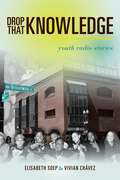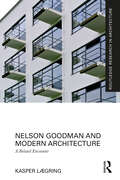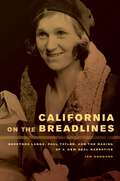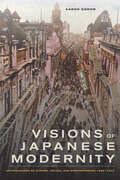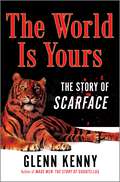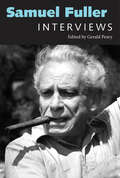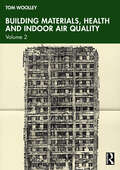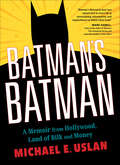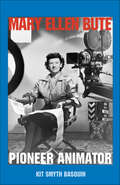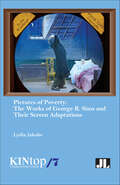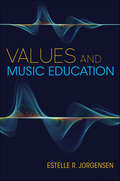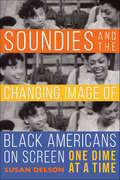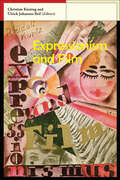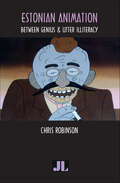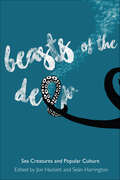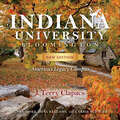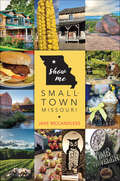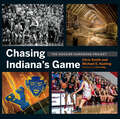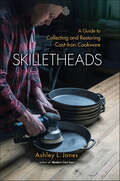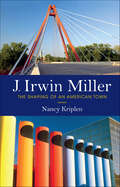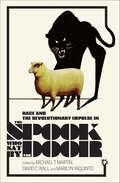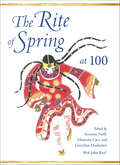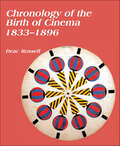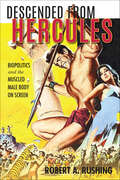- Table View
- List View
Drop That Knowledge: Youth Radio Stories
by Vivian Chavez Lissa soepThis is the first book to take us inside Youth Radio for a fascinating, behind-the-scenes look at a unique, Peabody Award-winning organization that produces distinctive content for outlets from National Public Radio to YouTube. Young people come to Youth Radio, headquartered in Oakland, California, from under-resourced public schools and neighborhoods in order to produce media that will transform both their own lives and the world around them. Drop That Knowledge weaves their compelling personal stories into a fresh framework for understanding the relationship between media, learning, and youth culture at a moment when all three spheres are undergoing dramatic change. The book emphasizes what is innovative and exciting in youth culture and offers concrete strategies for engaging and collaborating with diverse groups of young people on real-world initiatives in a range of settings, online and in real life.
Nelson Goodman and Modern Architecture: A Belated Encounter (Routledge Research in Architecture)
by Kasper LægringThis book orchestrates a convergence of two discourses from the 1960s—Nelson Goodman’s aesthetic theory on one side and critiques of modern architecture articulated by figures like Peter Blake, Charles Jencks, and Robert Venturi/Denise Scott Brown on the other. Grounded in Goodman’s aesthetic theory, the book explores his conceptual framework within the context of modern architecture.At the heart of the investigation lies Goodman’s concept of exemplification. While his notion of denotation pertains to representational elements, often ornaments, in architecture, exemplification accentuates specific formal properties at the expense of others, including color, spatial orientation, transparency, seriality, and the like. Supplemented by findings from phenomenology, the book traces these effects in buildings, notably those by Ludwig Mies van der Rohe, Walter Gropius, Le Corbusier, and Frank Lloyd Wright—all key figures in the critiques of modern architecture.Employing Goodman’s framework, the book aims to address accusations of emptiness and alienation directed at modern architecture in the postwar era. It illustrates that modern architecture symbolizes aesthetically in a fundamentally different way than architecture from earlier periods.This book will be of interest to architects, artists, researchers, and students in architecture, architectural history, theory, cultural theory, philosophy, and aesthetics.
California on the Breadlines: Dorothea Lange, Paul Taylor, and the Making of a New Deal Narrative
by Jan GoggansCalifornia on the Breadlines is the compelling account of how Dorothea Lange, the Great Depression’s most famous photographer, and Paul Taylor, her labor economist husband, forged a relationship that was private—they both divorced spouses to be together—collaborative, and richly productive. Lange and Taylor poured their considerable energies into the decade-long project of documenting the plight of California’s dispossessed, which in 1939 culminated in the publication of their landmark book, American Exodus: A Record of Human Erosion. Jan Goggans blends biography, literature, and history to retrace the paths that brought Lange and Taylor together. She shows how American Exodus set forth a new way of understanding those in crisis during the economic disaster in California and ultimately informed the way we think about the Great Depression itself.
Visions of Japanese Modernity: Articulations of Cinema, Nation, and Spectatorship, 1895-1925
by Aaron GerowJapan has done marvelous things with cinema, giving the world the likes of Kurosawa, Mizoguchi, and Ozu. But cinema did not arrive in Japan fully formed at the end of the nineteenth century, nor was it simply adopted into an ages-old culture. Aaron Gerow explores the processes by which film was defined, transformed, and adapted during its first three decades in Japan. He focuses in particular on how one trend in criticism, the Pure Film Movement, changed not only the way films were made, but also how they were conceived. Looking closely at the work of critics, theorists, intellectuals, benshi artists, educators, police, and censors, Gerow finds that this trend established a way of thinking about cinema that would reign in Japan for much of the twentieth century.
The World Is Yours: The Story of Scarface
by Glenn KennyThe behind-the-scenes story of the iconic film Scarface, featuring new interviews with the cast and crew. An unflinching confrontation of humanity&’s dark side, Brian De Palma&’s crime drama film Scarface gave rise to a cultural revolution upon its release in 1983. Its impact was unprecedented, making globe-spanning waves as a defining portrait of the gritty Miami street life. From Al Pacino&’s masterful characterization of Tony Montana to the iconic &“Say hello to my little friend,&” Scarface maintains its reputation as an unwavering game changer in cult classic cinema. With brand-new interviews and untold stories of the film&’s production, longtime film critic Glenn Kenny takes us on an unparalleled journey through the making of American depictions of crime. The World Is Yours highlights the influential characters and themes within Scarface, reflecting on how its storied legacy played such a major role in American culture.
Samuel Fuller: Interviews (Conversations with Filmmakers Series)
by Gerald PearyIn the early twentieth century, the art world was captivated by the imaginative, original paintings of Henri Rousseau, who, without formal art training, produced works that astonished not only the public but great artists such as Pablo Picasso. Samuel Fuller (1912–1997) is known as the “Rousseau of the cinema,” a mostly “B” genre Hollywood moviemaker deeply admired by “A” filmmakers as diverse as Jim Jarmusch, Martin Scorsese, Francois Truffaut, Jean-Luc Godard, and John Cassavetes, all of them dazzled by Fuller’s wildly idiosyncratic primitivist style. A high school dropout who became a New York City tabloid crime reporter in his teens, Fuller went to Hollywood and made movies post-World War II that were totally in line with his exploitative newspaper work—bold, blunt, pulpy, excitable. The images were as shocking, impolite, and in-your-face as a Weegee photograph of a gangster bleeding on a sidewalk. Fuller, who made twenty-three features between 1949 and 1989, is the very definition of a “cult” director, appreciated by those with a certain bent of subterranean taste, a penchant for what critic Manny Farber famously labeled as “termite art.” Here are some of the crazy, lurid, comic book titles of his movies: Shock Corridor, The Naked Kiss, Verboten!, and Pickup on South Street. Fuller isn’t for everybody. His fans have to appreciate low-budget genre films, including westerns and war movies, and make room for some hard-knuckle, ugly bursts of violence. They also have to make allowance for lots of broad, crass acting, and scripts (all Fuller-written) that can be stiff, sometimes campy, often laboriously didactic. Fuller is for those who love cinema—images that jump, shout, and dance. As he put it in his famous cigar-chomping cameo, acting in Jean-Luc Godard’s Pierrot le fou (1965): “Film is like a battleground . . . love, hate, violence, death. In a single word: emotion.” After directing, Fuller's greatest skill was conversation. He could talk, talk, talk, from his amazing experiences fighting in World War II to the time his brother-in-law dated Marilyn Monroe, and vivid stories about his moviemaking. Samuel Fuller: Interviews is not only informative about the filmmaker’s career but sheer fun, following the wild, uninhibited stream of Fuller’s chatter. He was an incredible storyteller, and no matter what the interview was, he had stories galore for all sorts of readers, not just for academics and film historians.
Building Materials, Health and Indoor Air Quality: Volume 2
by Tom WoolleyIn Building Materials, Health and Indoor Air Quality: Volume 2 Tom Woolley uses new research to continue to advocate for limiting the use of hazardous materials in construction and raise awareness of the links between pollutants found in building materials, poor indoor air quality and health problems. Chapters in this volume reinforce previous arguments and present new ones covering: Further evidence of the health impacts of hazardous emissions from materials Hazardous materials to be avoided and why Fire and smoke toxicity – the Lakanal House and Grenfell Tower legacy Sub-standard retrofits leading to damp and mould in previously sound houses A critical review of recent reports from UK Government and others on air quality and health problems including policy changes on flame retardants Growing evidence of cancer risks and the failure of cancer research organisations to address these issues A critical review of recent climate change and zero carbon policies and a discussion on whether extreme energy efficiency is a good thing This book asks some important and, for some, uncomfortable questions, but in doing so it brings to light important areas for research and provides much needed guidance for architects, engineers, construction professionals, students and researchers on hazardous materials and how to reduce their use and design and build healthier buildings for all occupants.
Batman's Batman: A Memoir from Hollywood, Land of Bilk and Money
by Michael E. UslanAn insider's look at Hollywood and how movies and television shows are made.In Batman's Batman, Michael E. Uslan, executive producer of the Batman movie franchise, offers an insider's look at Hollywood and the process of how movies and television shows go from the drawing board to your screens.Continuing the delightful tale of his adventures begun in The Boy Who Loved Batman, Uslan draws on both his successful and less successful attempts to bring ideas to the screen, offering a helpful, honest, and breezily told guide to producing films. From passion to promotion, from the initial pitch to selecting the best partners and packaging, Uslan reveals the 13 qualities essential to would-be producers. A lively memoir and a valuable glimpse inside Hollywood rarely seen by the public, Batman's Batman is sure to please fans of Michael Uslan and the Batman franchise, but will also prove to be an invaluable resource for any aspiring producers, as he guides readers through the Land of Bilk and Money.
Mary Ellen Bute: Pioneer Animator
by Kit Smyth BasquinMary Ellen Bute: Pioneer Animator captures the personal and professional life of Mary Ellen Bute (1906–1983) one of the first American filmmakers to create abstract animated films in 1934, also one of the first Americans to use the electronic image of the oscilloscope in films starting in 1949, and the first filmmaker to interpret James Joyce's literature for the screen, Passages from James Joyce's Finnegans Wake, a live-action film for which she won a Cannes Film Festival Prize in 1965. Bute had an eye for talent and selected many creative people who would go on to be famous. She hired Norman McLaren to hand paint on film for the animation of her Spook Sport, 1939, before he left to head the animation department of the Canadian Film Board. She cast the now famous character actor Christopher Walken at age fourteen as the star of her short live-action film, The Boy Who Saw Through, 1958. Also, Bute enlisted Elliot Kaplan to compose the film score of her Finnegans Wake before he moved on to compose music for TV's Fantasy Island and Ironside. This biography drawn from interviews with Bute's family, friends, and colleagues, presents the personal and professional life of the filmmaker and her behind-the-scenes process of making animated and live action films.
Pictures of Poverty: The Works of George R. Sims and Their Screen Adaptations (Kintop Studies In Early Cinema Ser.)
by Lydia JakobsFrom Charles Dickens's Oliver Twist to George Sims's How the Poor Live, illustrated accounts of poverty were en vogue in Victorian Britain. Poverty was also a popular subject on the screen, whether in dramatic retellings of well-known stories or in 'documentary' photographs taken in the slums. London and its street life were the preferred setting for George Robert Sims's rousing ballads and the numerous magic lantern slide series and silent films based on them. Sims was a popular journalist and dramatist, whose articles, short stories, theatre plays and ballads discussed overcrowding, drunkenness, prostitution and child poverty in dramatic and heroic episodes from the lives and deaths of the poor. Richly illustrated and drawing from many previously unknown sources, Pictures of Poverty is a comprehensive account of the representation of poverty throughout the Victorian period, whether disseminated in newspapers, illustrated books and lectures, presented on the theatre stage or projected on the screen in magic lantern and film performances. Detailed case studies reveal the intermedial context of these popular pictures of poverty and their mobility across genres. With versatile author George R. Sims as the starting point, this study explores the influence of visual media in historical discourses about poverty and the highly controversial role of the Victorian state in poor relief.
Values and Music Education (Counterpoints: Music and Education)
by Estelle R. JorgensenWhat values should form the foundation of music education? And once we decide on those values, how do we ensure we are acting on them?In Values and Music Education, esteemed author Estelle R. Jorgensen explores how values apply to the practice of music education. We may declare values, but they can be hard to see in action. Jorgensen examines nine quartets of related values and offers readers a roadmap for thinking constructively and critically about the values they hold. In doing so, she takes a broad view of both music and education while drawing on a wide sweep of multidisciplinary literature. Not only does Jorgensen demonstrate an analytical and dialectical philosophical approach to examining values, but she also seeks to show how theoretical and practical issues are interconnected.An important addition to the field of music education, Values and Music Education highlights values that have been forgotten or marginalized, underscores those that seem perennial, and illustrates how values can be double-edged swords.
Soundies and the Changing Image of Black Americans on Screen: One Dime at a Time
by Susan DelsonIn the 1940s, folks at bars and restaurants would gather around a Panoram movie machine to watch three-minute films called Soundies, precursors to today's music videos. This history was all but forgotten until the digital era brought Soundies to phones and computer screens—including a YouTube clip starring a 102-year-old Harlem dancer watching her younger self perform in Soundies. In Soundies and the Changing Image of Black Americans on Screen: One Dime at a Time, Susan Delson takes a deeper look at these fascinating films by focusing on the role of Black performers in this little-known genre. She highlights the women performers, like Dorothy Dandridge, who helped shape Soundies, while offering an intimate look at icons of the age, such as Duke Ellington and Nat King Cole. Using previously unknown archival materials—including letters, corporate memos, and courtroom testimony—to trace the precarious path of Soundies, Delson presents an incisive pop-culture snapshot of race relations during and just after World War II.Perfect for readers interested in film, American history, the World War II era, and Black entertainment history, Soundies and the Changing Image of Black Americans on Screen and its companion video website (susandelson.com) bring the important contributions of these Black artists into the spotlight once again.
Expressionism and Film
by Rudolf KurtzExpressionism and Film, originally published in German in 1926, is not only a classic of film history, but also an important work from the early phase of modern media history. Written with analytical brilliance and historical vision by a well-known contemporary of the expressionist movement, it captures Expressionism at the time of its impending conclusion—as an intersection of world view, resoluteness of form, and medial transition. Though one of the most frequently-cited works of Weimar culture, Kurtz's groundbreaking work, which is on a par with Siegfried Kracauer's From Caligari to Hitler and Lotte Eisner's The Haunted Screen, has never been published in English. Its relevance and historical contexts are analyzed in a concise afterword by the Swiss scholars Christian Kiening and Ulrich Johannes Beil.
Estonian Animation: Between Genius & Utter Illiteracy
by Chris RobinsonEver wonder why Estonian animation features so many carrots or why cows often perform pyramids? Well, neither question is answered in Chris Robinson's new book, Estonian Animation. Robinson's frank, humorous, and thoroughly researched book traces the history of Estonia's acclaimed animation scene from early experiments in the 1930s to the creation of puppet (Nukufilm) and cel (Joonisfilm) animation studios during the Soviet era, as well as Estonia's surprising international success during the post-Soviet era. In addition, Robinson writes about the discovery of films by four 1960s animation pioneers who, until the release of this book, had been unknown to most Estonian and international animation historians.
Plant-Based Himalaya: Vegan Recipes from Nepal
by Babita ShresthaThe art of healthy cooking is all about loving yourself and spreading that love to those around you. It's even better when you can cook a delicious meal and also help protect the environment. In Plant-Based Himalaya, Nepalese author Babita Shrestha shares 38 vegan recipes from her home country that she has been cooking and eating since she was very young, including mouthwatering grains, dal, curries, greens, sauces, and desserts. In addition to food, Shrestha introduces her beloved Nepal along with her personal goals for a plant-based diet: decreasing mass production and consumption of unhealthy processed food in plastic packaging. Featuring 250 beautiful full-color photos, Plant-Based Himalaya is designed to inspire you to cook and eat exquisitely vegan home-style Nepali cuisine. Make it exceptional, and share it with your loved ones!
Beasts of the Deep: Sea Creatures and Popular Culture
by Jon Hackett and Seán HarringtonBeasts of the Deep: Sea Creatures and Popular Culture offers its readers an in-depth and interdisciplinary engagement with the sea and its monstrous inhabitants; through critical readings of folklore, weird fiction, film, music, radio and digital games. Within the text there are a multitude of convergent critical perspectives used to engage and explore fictional and real monsters of the sea in media and folklore. The collection features chapters from a variety of academic perspectives; post- modernism, psychoanalysis, industrial-organisational analysis, fandom studies, sociology and philosophy are featured. Under examination are a wide range of narratives and media forms that represent, reimagine and create the Kraken, mermaids, giant sharks, sea draugrs and even the weird creatures of H.P. Lovecraft.Beasts of the Deep offers an expansive study of our sea-born fears and anxieties, that are crystallised in a variety of monstrous forms. Repeatedly the chapters in the collection encounter the contemporary relevance of our fears of the sea and its inhabitants – through the dehumanising media depictions of refugees in the Mediterranean to the encroaching ecological disasters of global warming, pollution and the threat of mass marine extinction.
Indiana University Bloomington: America's Legacy Campus (Well House Books)
by J. Terry Clapacs Susan Moke Dina Kellams Carrie SchwierAmid the forested hills of southern Indiana stands one of America's most beautiful college campuses. Indiana University Bloomington: America's Legacy Campus, the new edition, returns the reader to this architectural gem and cultural touchstone. Revised and updated to include new buildings and features of campus life, it is a must have for any Hoosier. The IU Bloomington campus, rich in architectural tradition, harmonious in building scale and materials, and surrounded by natural beauty, stands today as a testimony to careful campus planning and committed stewardship. Planning principles adopted in the very early stages of campus development have been protected, enhanced, and faithfully preserved, resulting in an institution that can truly be called America's Legacy Campus. Lavishly illustrated and brimming with fascinating details, this book tells the story of Indiana University—a tale not only of buildings, architecture, and growth, but of the talented, dedicated people who brought the buildings to life. Completely updated with new buildings and an epilogue, and now even more lavishly illustrated, this new edition is a lasting tribute to the treasure that is Indiana University Bloomington.
Show Me Small-Town Missouri
by Jake McCandlessWhere was Mark Twain born? What city has claim to a president who was only president for a day? Who has the best paddling trips in the Ozarks? What about the World's Largest Gift Store? Find these answers and more in Show Me Small-Town Missouri. Award-winning author Jake McCandless, a lover of small towns and adventures, traveled the state in search of amazing local experiences to share this treasure trove of what you can find in often-overlooked towns across Missouri. Featured are 90 sparkling gems found in all four of the state's geographical regions—the Northern Prairie, the Southwest Osage Plain, the Ozarks, and the Bootheel Lowlands. The must-see attractions, activities, restaurants, sweet shops, specialty shops, and unique vacation spots are showcased in full-color images with an easy-to-follow index to help you plan your trip.From galleries to hiking trails, candy factories to wineries, lakeside attractions to the best fireworks displays, Show Me Small-Town Missouri has everything you need to know for a day, weekend, or week full of fun.
Chasing Indiana's Game: The Hoosier Hardwood Project
by Chris Smith Michael E. KeatingHoosiers have always loved basketball! Long before Larry Bird carried Indiana State University to the 1979 NCAA National Championship or Bobby Knight walked the sidelines at Indiana University, basketball fostered community identity across the Hoosier state. From Indiana's tiniest towns to its biggest cities, high school basketball is a source of pride, unifying communities with different races, religions, and social and economic status.First drawn simply to documenting the architecture of Indiana's high school buildings and basketball courts, Chris Smith and Michael Keating quickly discovered that the real story was about more than just brick and mortar, maple and shellac. Told repeatedly by locals how important these places were to their communities, they began to embrace the "game on Saturday, church on Sunday" mantra that is found in many towns through Indiana, watching countless hours of basketball and becoming a part of the Hoosier tradition themselves. With over 150 color photographs and unforgettable stories from high school basketball and beyond, Chasing Indiana's Game: The Hoosier Hardwood Project is a tribute to the Hoosier state and all who love basketball.
Skilletheads: A Guide to Collecting and Restoring Cast-Iron Cookware
by Ashley L. JonesPart science and part personal preference, collecting and restoring cast-iron cookware is a complex art. For instance, what makes each company's cast iron unique? Do chemicals used during restoration leach into food? When it comes to surface finish, is textured or smooth better?In Skilletheads, the highly anticipated follow-up to Modern Cast Iron, Ashley L. Jones dives deeper than ever into the world of cast iron. In these pages, which feature over 100 full-color photos, you'll find expert advice on purchasing cast iron from some of the most active collectors in the field today; side-by-side comparisons of the major manufacturers in the US and interviews with each company; and detailed how-to guides for restoring cast iron, including such methods as lye baths, electrolysis tanks, and chemical products, all compiled with input from devoted Skilletheads. And because no book on cast iron is complete without a little cooking, Jones includes 35 mouth-watering recipes contributed by foodies who know cast iron best—everything from Sunday Frittata to Braised Chicken to Skillet S'mores.Whether you're interested in finding the perfect pan for your kitchen or starting a new hobby restoring cast iron, Skilletheads is here to help.
J. Irwin Miller: The Shaping of an American Town
by Nancy KriplenJ. Irwin Miller:The Shaping of An American Town tells the life story of this remarkable man who led Cummins Engine Company from its roots as a small, family business to an international Fortune 500 company and transformed Columbus, Indiana, into a gem of midcentury modern architecture. As president and then chairman of Cummins, Miller emphasized a corporation's responsibility to the community in which it was located and its other stakeholders. Miller's commitment to Columbus architecture inspired such legends as I. M. Pei, Eliel and Eero Saarinen, Kevin Roche, and others to contribute their designs to what has become one of the most artistically revolutionary towns in the country. Columbus's unique public art and architecture continue to inspire young architects and attract visitors from around the world. Miller has also played a significant role in the American civil rights movement, securing cosponsorship for the March on Washington and working with presidents John F. Kennedy and Lyndon Johnson to help pass the Civil Rights Act. Martin Luther King Jr., once called Miller "the most socially responsible businessman in the country."
Race and the Revolutionary Impulse in The Spook Who Sat by the Door (Studies in the Cinema of the Black Diaspora)
by Michael T. Martin, David C. Wall and Marilyn YaquintoIvan Dixon's 1973 film, The Spook Who Sat by the Door, captures the intensity of social and political upheaval during a volatile period in American history. Based on Sam Greenlee's novel by the same name, the film is a searing portrayal of an American Black underclass brought to the brink of revolution. This series of critical essays situates the film in its social, political, and cinematic contexts and presents a wealth of related materials, including an extensive interview with Sam Greenlee, the original United Artists' press kit, numerous stills from the film, and the original screenplay. This fascinating examination of a revolutionary work foregrounds issues of race, class, and social inequality that continue to incite protests and drive political debate.
The Rite of Spring at 100 (Musical Meaning and Interpretation)
by John ReefWhen Igor Stravinsky's ballet Le Sacre du printemps (The Rite of Spring) premiered during the 1913 Paris season of Sergei Diaghilev's Ballets Russes, its avant-garde music and jarring choreography scandalized audiences. Today it is considered one of the most influential musical works of the twentieth century. In this volume, the ballet finally receives the full critical attention it deserves, as distinguished music and dance scholars discuss the meaning of the work and its far-reaching influence on world music, performance, and culture. Essays explore four key facets of the ballet: its choreography and movement; the cultural and historical contexts of its performance and reception in France; its structure and use of innovative rhythmic and tonal features; and the reception of the work in Russian music history and theory.
Chronology of the Birth of Cinema, 1833–1896
by Deac RossellWritten from an international perspective, this account of the origins of the cinema begins in 1833 with the introduction of optical toys for reproducing movement and ends with a thorough examination of the first full year of projected moving pictures in 1896. Comprehensive and verifiable, with citations that support each individual entry, the book examines the events that culminated in the establishment of the moving picture world that was the dominant visual medium of the last century. Drawing on a range of international sources, this chronology is a readable, vivid account that corrects many longstanding errors in the story of moving pictures while at the same time recording the astounding diversity of ideas, apparatus, personalities, and exhibitions that turned a passing novelty into a major industry. Populated by dreamers, inventors, scientists, and entrepreneurs with widely different skills, interests, and backgrounds, the many origins of the cinema are all recorded here in a rich tapestry that has been woven with attention to the detailed shape and placement of each individual thread. The result is a fully- indexed reference that reflects the state of modern scholarship and should be useful over the long term as both a reference to the period of early cinema and as a starting point for further research.
Descended from Hercules: Biopolitics and the Muscled Male Body on Screen (New Directions in National Cinemas)
by Robert A. RushingMuscles, six-pack abs, skin, and sweat fill the screen in the tawdry and tantalizing peplum films associated with epic Italian cinema of the 1950s and 1960s. Using techniques like slow motion and stopped time, these films instill the hero's vitality with timeless admiration and immerse the hero's body in a world that is lavishly eroticized but without sexual desire. These "sword and sandal" films represent a century-long cinematic biopolitical intervention that offers the spectator an imagined form of the male body—one free of illness, degeneracy, and the burdens of poverty—that defends goodness with brute strength and perseverance, and serves as a model of ideal citizenry. Robert A. Rushing traces these epic heroes from Maciste in Cabiria in the early silent era to contemporary transnational figures like Arnold Schwarzenegger in Conan the Barbarian, and to films such as Zach Snyder's 300. Rushing explores how the very tactile modes of representation cement the genre's ideological grip on the viewer.
